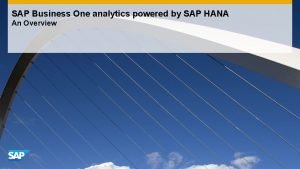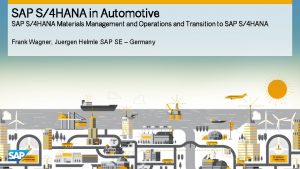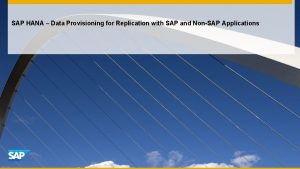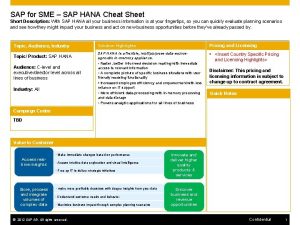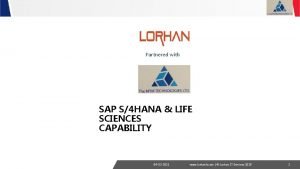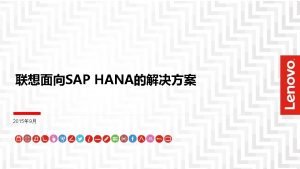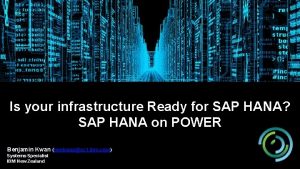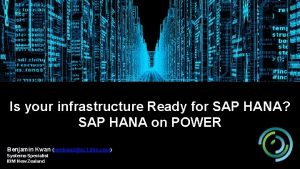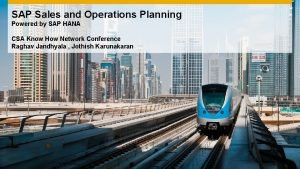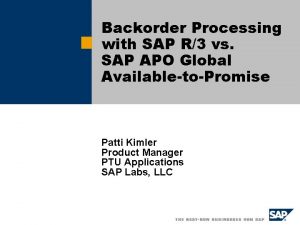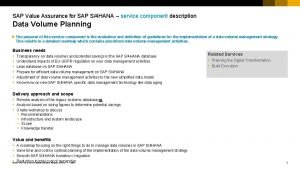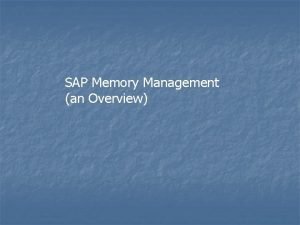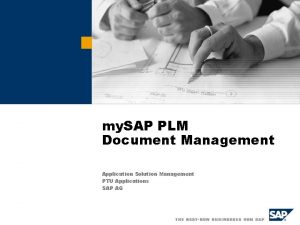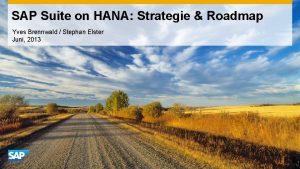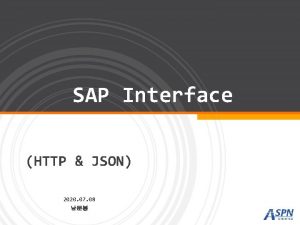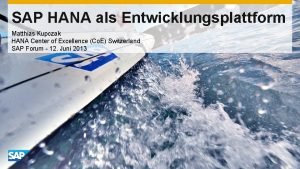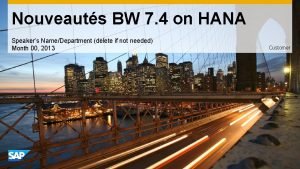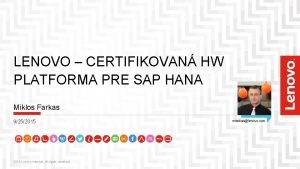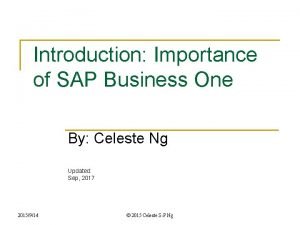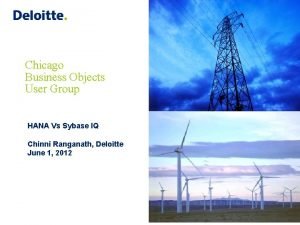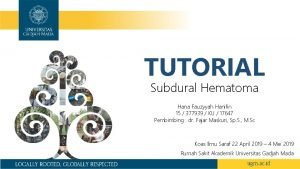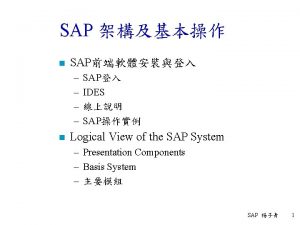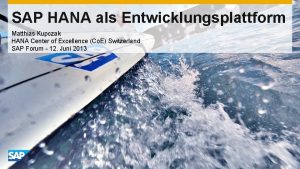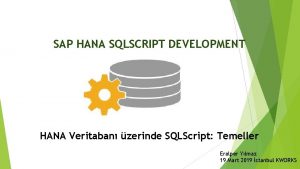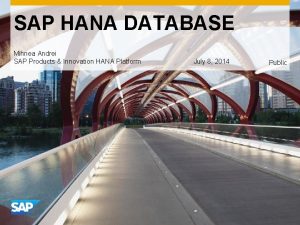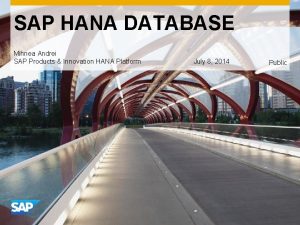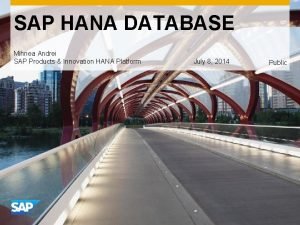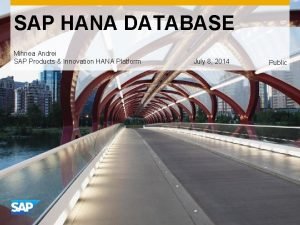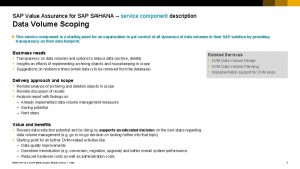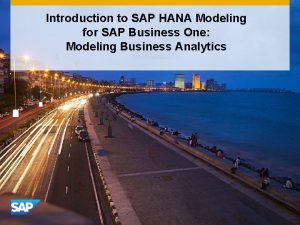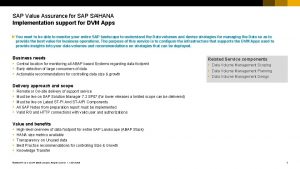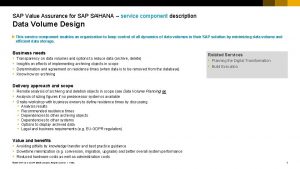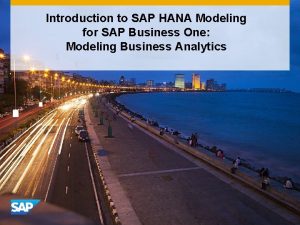Is your infrastructure Ready for SAP HANA SAP

































- Slides: 33

Is your infrastructure Ready for SAP HANA? SAP HANA on POWER Benjamin Kwan (benkwan@nz 1. ibm. com) Systems Specialist IBM New Zealand

Evolution of SAP S/4 HANA SAP started out with R/1 and R/2 as a real-time system offering on the mainframe. Initially it was a 1 tier system, which then became 2 tier with R/2 By this time, distributed Unix and Windows systems were available and SAP ported their ERP application to these platforms as R/3 Multiple components were merged into SAP ERP such as BW, SEM and ITS. The business logic and technical layer were separated for ease of implementation SAP introduces its own in-memory database. HANA will enable applications to run both transactional and analytical workloads on a single copy of the data SAP ports its Business Suite applications to run on HANA SAP introduces S/4 HANA, an ERP replacement, that will form the Digital Core of SAP’s modernization of the enterprise business processes 2

Rapid adoption of SAP HANA on POWER Systems Acceleration: 0 to >1500 clients in 36 months 50+ CSP/MSP using IBM POWER for SAP HANA Clouds 4 out of the top 10 Fortune 500 Global 60% faster from procurement to go-live (e. g. 2. 5 months instead of 6) 17 out of the top 135 European Companies 2018 SAP Pinnacle awards Winner • IBM POWER Systems - Global Partner of Year – Infrastructure • Seidor - running on POWER, Cloud Partner of the Year 3

What makes IBM Power Systems the best platform for clients’ mission critical SAP HANA deployments? Risk-free sizing and implementation Flexibility Superior virtualization and management features to afford flexibility and maximum utilization Resiliency – Dynamically adjust sizing to changing requirements – Grow number of systems and sizes on demand while project advances Unsurpassed RAS (reliability, availability, serviceability) characteristics to support mission critical SAP applications Reliable infrastructure for enterprise applications Performance Best infrastructure to achieve scalability, response time and throughput requirements Highest throughput per core and core/memory bandwidth to deliver faster business results, up to 2 x Intel-based alternatives Competitive Cost – Additional headroom for peak workload due to virtualization capabilities TCA: competitive to x 86 TCO: better than x 86 4

Virtualization 5

SAP HANA Components on IBM Power Systems Simplification of Operation with Power. VM HANA Production HANA DEV HANA QA SUSE / RHEL Power + Power. VM CPU RAM Storage Network 6

Powerful Flexibility in Virtualization with IBM Power Donating: HANA LPAR can give unused CPU cycles to the Shared LPAR´s S A P P L H A N A Q A D E V A I X S A P i 5 / O S Shared LPARs L i n u x SAP HANA DB PROD Resizing: HANA LPAR can resized by Cores or any size of Memory (increase or decrease) * Dedicated or Ded. Donating LPARs Power. VM Hypervisor Dynamic LPARs: LPARs can share CPU cycles and Memory. Manged by the Power Hypervisor * *) Due missing functionality in SAP HANA, Memory and Core changes required a restart of the HANA application 7

SAP HANA on IBM POWER Virtualization advantage with LPAR SAP HANA SAP HANA DB DB PROD PROD Dedicated or Dedicated Donating LPARs Power. VM Hypervisor Up to 16 SAP HANA Production DBs No limit on NON Production and other workload 8

01: 00 03: 00 05: 00 07: 00 09: 00 11: 00 13: 00 15: 00 17: 00 19: 00 21: 00 23: 00 Batch Web Services 00: 00 02: 00 04: 00 06: 00 08: 00 10: 00 12: 00 14: 00 16: 00 ERP / Dialogue 18: 00 20: 00 22: 00 24: 00 • Many SAP applications are integrated from a business and date perspective but not from a workloads point of view • They are managed as separate servers/LPARs • Results in low degree of synergy POWER Approach Batch my. SAP BI Processor Utilization Percentage SAP Net. Weaver BI 4 UNIX Instances, 4 separate SMPs or Partitions IBM Virtualization provides excellent Integration and Consolidation my. SAP ERP Web Services • POWER processor-based systems and manageability features allow workload ‘combination’ while still keeping applications distinct • Higher Server Utilization • Reduced Complexity • Reduced Average Cost 9

Enterprise Level Virtualization § Consolidate multiple HANA workloads onto fewer systems, increasing server utilization. § Live Partition Mobility (LPM) avoids service impact due to systems maintenance § HANA benefits from Enterprise Resource Pool (EP) and Cores on Demand (COD) by accessing capacity and resources in unexpected situations. § Power. VC improve administrator productivity and simplifies the management of HANA VMs and LPARs on POWER Systems servers.

IBM Power Systems the Most Reliable Servers after IBM Z How much Unplanned Downtime have you experienced, per server/per annum in minutes in 2017 – 2018? 2. 1 minutes per year Source: ITIC 2017 – 2018 Global Server Hardware, Server OS Reliability Report 11

Systems Architecture vs x 86 • SMT enables higher throughput and reduces core count. Particularly suited to support HANA features such as the HANA indexing server, which is know to spawn many hundred threads. SMT technologies have been built to handle this type of behaviour • Large memory footprints enable larger single node HANA in-memory database systems and provide more flexibility to consolidate workloads • POWER systems feature superior CPU and Memory bandwidth to handle HANA in-memory data operations faster 4 x threads per core vs. Intel 24 TB* larger memory space vs. Intel 1. 8 x system bandwidth vs. Intel • Higher CPU clock speeds and overall processing capabilities leading to HANA record benchmarks * Scale-up for S/4 and So. H. For BW/4 HANA or BWo. H, the max is 16 TB 2 x core performance vs. Intel

IBM POWER 9 achieves 115% more SAPS per Core than Intel latest x 86 Skylake Platinum from Q 3/2017 SAP SD 2 -tier Intel Skylake Platinium SAPS per Core 2500. 00 2000. 00 1000. 00 2421 1500. 00 3022 5451 3000. 00 > 6500 3500. 00 IBM POWER 8 Lenovo Dell EMC 2 s - 56 c 2 socket FUJITSU Lenovo 4 s - 112 c 4 socket Details see: http: //global. sap. com/solutions/benchmark/sd 2 tier. epx HPE 8 s - 224 c IBM POWER 9 8 socket 13

NEW: SAP HANA TDI Phase 5 is there 14

TDI Phase 5: Responsibility of Customer and/or Partner 15

Better Total Cost of Ownership As business grows, the HANA database size increases, and larger server memory is required In the SAP 2 -socket server certification, POWER 9 systems can support 33% larger HANA databases than x 86 servers (4 TB vs. 3 TB) AND With less than half the cores Which results in ü Lower purchase and maintenance cost for smaller servers ü Lower power consumption ü Lower complexity Don’t get trapped by hardware restrictions 16

TCO Comparison Cloud, x 86 and Power Swiss Customer case 2018 IBM IT Economics Team IT. Economics@us. ibm. com Assumed workload growth : year 1 => 25% , year 2 and 3 => 5% , year 4 and 5 => 0% Main Assumptions • • People cost Power & Cloud to x 86 assumed to be 1, 5 : 2 Power discount typical for large client conditions For x 86 an end price of 30 k per TB is assumed for servers > 512 GB For Cloud (Azure) a premium network connection with unlimited data transfer is assumed and 50% discount on list price is assumed. 17

TCO TCA Total Cost of Ownership (TCO) is much more than Total Cost of Acquisition (TCA)! Components Environments Time Prod Dev Test QA DR Hardware $ $ $ Planning Software $ $ $ Upgrades People $ $ $ Migration Network $ $ $ Growth Storage $ $ $ Parallel Costs Facilities $ $ $ Net Present Value Qo. S – Availability, Reliability, Security and Scalability TCO study by: CTO Systems DACH & SOLAR Team &

POWER 8 Systems Server Family ALL systems are certified for use with SAP Business Suite ALL systems are supporting SAP HANA Power Systems E 850 4 U POWER Systems • • 4 -socket, Up to 48 cores • 4 TB memory* Power Systems S 824 • 11 PCIe Gen 3 • 2 -socket, 4 U E 870/E 880 • AIX, Linux • Up to 24 cores POWER Systems • 4 -sockets per Drawer • Power. VM • 2 TB memory POWER Systems • Up to 64 / 192 cores • 11 PCIe Gen 3 S 814 • Max. of 8 / 32 TB S 822 • AIX, IBM i, Linux POWER Systems • 1 -socket, 4 U memory • Power. VM • 2 -socket, 2 U • Up to 8 cores • AIX 7. 1 TL 03+SP, 6. 1 • Up to 20 cores POWER Systems S 822 L • 512 GB memory TL 09+SP • 9 PCIe Gen 3 • 2 -socket, 2 U • 7 PCIe Gen 3 • i 5 OS 7. 2 TR 1, 7. 1 TR 9 S 812 L • AIX & Linux • Up to 24 cores • AIX, IBM i, Linux • RHEL 7, 6. 6 • 1 -socket, 2 U • Up to 12 cores • • POWER 8 512 GB memory 6 PCI Gen 3 Linux only Power. VM or Power. KVM • • 1 TB memory 9 PCI Gen 3 Linux only Power. VM or Power. KVM • Power. VM • SLES 12, 11 SP 3 • AIX, Linux • Power. VM

Next Generation HANA on POWER IBM POWER 9 Family Optimized for SAP HANA in-memory database workloads H 922 • 1, 2 -socket, 2 U • 4, 8, and 10 cores per socket • 4 TB memory H 924 • 2 -socket, 4 U • 8, 10, and 12 cores per socket • 4 TB memory Ideal for Scale-Out configurations E 950 • 2, 4 -socket, 4 U • 8, 10, 11, and 12 cores per socket • 16 TB memory E 980 • 5 U CEC + 2 U Control Unit • Max of 192 SMT 8 processor cores • 8, 10, 11, and 12 cores per socket • 64 TB memory Ideal for Scale-Up configurations

Live Business Case Current X 86 Environment Power 9 Physical Servers Operating Systems Instances 28 28 2 8 Inter-node connections Dedicated Network Switches 56 6 0 0 Internal Disk & multiple External SANs 7 2, 240 2 x Enterprise SAN 2 192 Storage Sites Cores 21

Visit us at the IBM Booth to book your complimentary SAP on Power infrastructure assessment! What if you could make business decisions faster while reducing IT spend? In 2018 SAP named IBM the SAP Global Partner of the Year - Infrastructure. Clients across the globe have realised that Power Systems is better suited than x 86 to provide the performance, stability, and reliability they need to achieve their business transformation goals. To support you on your SAP journey, IBM is offering an obligation free complimentary halfday workshop* for your business. The workshop will explore the considerations best designed to support a SAP deployment on Power Systems and the benefits of migrating to IBM Power Systems for SAP. Visit me at the IBM Booth to find out more! *Terms and conditions available at the IBM Booth.

Thank you. Questions 23

24

IBM Power Systems Virtualization Options Shared Pool support for Production HANA DB: already on SAPs Roadmap Early Adoption Program opened from SAP now 25

VMware has 1009 Vulnerabilities Power. VM has 0 Vulnerabilities 1009 Source: https: //nvd. nist. gov/vuln/search/results? form_type=Basic&results_type=overview&query=VMware&search_type=all 26

VMware has 1009 Vulnerabilities Power. VM has 0 Vulnerabilities 1009 IBM Power. VM: Source: https: //nvd. nist. gov/vuln/search/results? form_type=Basic&results_type=overview&query=VMware&search_type=all 0 27

SAP HANA Relevant v. Sphere limitations Production 6. 5 6. 7 6 TB *** * Power. VM: 32 TB per LPAR or Host *) v. Sphere 6. 0/6. 5 for multiple-VM production **) with selected server OEM partners only RAM Per ESX Host: Up to 6 TB is supported for ESXi 5. 5 Update 2 ***) VMware 6. 5 and 6. 7: 6 TB RAM per VM – since 09/2018 SAP supports 6 TB for HANA 28

2393917 - SAP HANA on VMware v. Sphere 6. 5 and 6. 7 in production Version 13 - 17. 09. 2018 Only max 8 socket Broadwell and Skylake support 09/2018: after 1 year on the market Skylake is now support Max VM: 6 TB and 128 v. CPUs (64 physical cores) on So. H/S 4 H with Skylake Maximum VMs: Broadwell: 128 v. CPUs (64 cores) on 4 sockets. 4 TB So. H/S 4 H. 2 TB BWo. H Skylake: 128 v. CPUs (64 cores) on 4 sockets. 6 TB So. H/S 4 H. 3 TB BWo. H VM sizing penalty. Customer shall plan more CPU capacity: • OLAP / BWo. H: 14% per VM when using ½ sockets • SAP and VMware saw degradation compared in performance on bare metal in average of 10% Power. VM is much more flexible and has NO overhead 29

Example VMware v. Sphere 6. 7: VMs for PROD HANA DBs on Intel Broadwell 8 sockets half-socket minimum VM size VM VM VM One socket granularity for scaling to a maximum of 4 sockets on a 8 socket box VM HANA Prod 1/2 x E 7 12 Cores 24 v. CPUs 512 GB Socket VM VM VM HANA Prod 2 x E 7 48 Cores 96 v. CPUs 2048 GB Socket Socket VMware v. Sphere 6. 5 or 6. 7 Only Broadwell and Skylake support Maximum size of a virtual machine on VMware v. Sphere 6. 5 or 6. 7 release, which is 128 v. CPUs and 4 TB of memory on Boadwell. 2, 4 or 8 socket Intel Broadwell Example HPE Integrity MC 990 X Intel Ex E 7 V 4 24 Core - 8 sockets - 8 TB memory Max memory per socket for 8 -socket Broadwell: BWo. H/DM/So. H/S 4 H: So. H/S 4 H – NO BW possible: 512 GB 1024 GB after 1 year on the market Skylake is now supported 30

on 33

Certified Hyper-Converged Infrastructure Solutions for HANA https: //www. sap. com/dmc/exp/2014 -09 -02 -hana-hardware/en. EN/hci. html Think. Agile HX 7820, HX 7821 4 x Intel Skylake Platinum 8180 M 3 TB memory (768 GB per socket) Dell EMC XC 740 xd, XC 940 4/2 x Intel Skylake Gold 6154 / 6126 768 GB, 384 GB memory 34

2686722 - SAP HANA virtualized on Nutanix Acropolis Hypervisor Version 2 from 18. 09. 2018 By issuing this SAP Note, SAP declares support for SAP HANA on Nutanix Akropolis, providing the following conditions are met: SAP HANA start release: SAP HANA 1. 0 SPS 12 (122. 19) Single and multiple SAP HANA production virtual machines on a single physical server CPU Architecture: Intel Skylake 2 & 4 socket (only supported processors) The minimum size of a virtual SAP HANA instance is a full socket (represented by at least 8 physical cores). The minimum is 128 GB of RAM. The maximum size of a virtual SAP HANA instance is limited CPU-wise by the maximum size of a virtual machine on Nutanix AHV release, which is 168 v. CPUs on 3 Sockets (3 Sockets only on 4 Socket Hardware), and 2, 3 TB of RAM. VM Size – full socket minimum 1 socket / maximum 3 sockets 1 - and 2 -socket VMs on 2 -socket (partly QPI meshed) 1 -, 2 - and 3 -socket VMs on 4 -socket server (fully QPI meshed) Rules for virtualized SAP HANA on Nutanix AHV Each SAP HANA instance / virtual machine is sized according to the existing SAP HANA sizing guidelines and Nutanix recommendations. CPU and Memory over-commitment must not be used. The Time Stamp Counter (TSC) must be synchronized between all sockets/cores. Certified OS versions (from SUSE) and server combinations as listed on the SAP HANA hardware directory are supported when virtualized. SAP HANA Tailored Datacenter Integration (TDI) delivery methods are not supported for SAP HANA on Nutanix. The hardware must be listed on the SAP HANA hardware directory under “HCI certified hardware”. The SAP HANA installation must done by an SAP certified engineer, qualified as "SAP Certified Technology Specialist - Required exam: C_HANATEC_11 (*) - See SAP Training and Certification Shop for details [2] The SAP HANA Installation on SAP HANA HCI certified hardware must be successfully verified with the SAP HANA hardware configuration check tool [3]. Configuration and overall setup must comply with the latest version of the bestpractice guide [4] and the here linked most recent best practice guide. This includes compliance to the SAP HANA core-to-memory ratio as reflected in the HANA Hardware Directory and virtualization calculus as described in the best practice guide as well as priority for SAP HANA production workloads over co-deployed non-production workloads. The ownership of the support is with the SAP HANA hardwarevendor providing the solution. In case of software issues SAP and Nutanix will jointly support virtual SAP HANA in production adhering to the SLAs defined in the customer support contract. If a reported problem is a known SAP HANA issue with a validated fix, SAP support will recommend the appropriate fix directly to the customer. For all other performance related issues, the customer will be referred within SAP’s OSS system to the SAP HANA hardwarevendor for support. The SAP HANA hardwarevendor will take ownership and work with Nutanix and SAP and the customer to identify the root cause. SAP support may request that additional details be gathered by the customer or the SAP HANA HW partner to help with troubleshooting issues. In rare cases – SAP may require to re-produce the issue on SAP HANA running in a bare metal environment. SAP and Nutanix saw degradation compared in performance on bare metal in average of 4%, and this is to be expected in virtualized environments. Customers are encouraged to size correct and test performance before going live. The socket pinned to the Nutanix CVM must not be used for productive HANA workloads. Non productive and non -HANA are fine. Ist only a hardware partitioning 35
 Sap business one analytic
Sap business one analytic Stay ready to keep from getting ready
Stay ready to keep from getting ready Sap hana for automotive
Sap hana for automotive Hana data provisioning
Hana data provisioning Sap for sme
Sap for sme Sap s4 hana for life science industry
Sap s4 hana for life science industry Lssue
Lssue Ibm power9 saps per core
Ibm power9 saps per core Sap hana tdi phase 5
Sap hana tdi phase 5 Sap hana predictive analysis library
Sap hana predictive analysis library Sap demand driven sales and operations planning
Sap demand driven sales and operations planning Sap backorder processing
Sap backorder processing Sap value assurance services
Sap value assurance services Em/initial_size_mb
Em/initial_size_mb It company
It company Plm dms
Plm dms Rollshot huawei
Rollshot huawei Qa cheat sheet
Qa cheat sheet Hana strategie
Hana strategie Cl_trex_json_serializer
Cl_trex_json_serializer Arquitetura sap hana
Arquitetura sap hana Sap hana analysis process
Sap hana analysis process Platforma sap
Platforma sap Sap hana 전망
Sap hana 전망 Sap hana hint
Sap hana hint Hana sybase
Hana sybase Give us your hungry your tired your poor
Give us your hungry your tired your poor Iso 22301 utbildning
Iso 22301 utbildning 377939
377939 Michelangelo
Michelangelo Hana slivkova
Hana slivkova Hana korac
Hana korac Hana korac
Hana korac Typiska novell drag
Typiska novell drag
